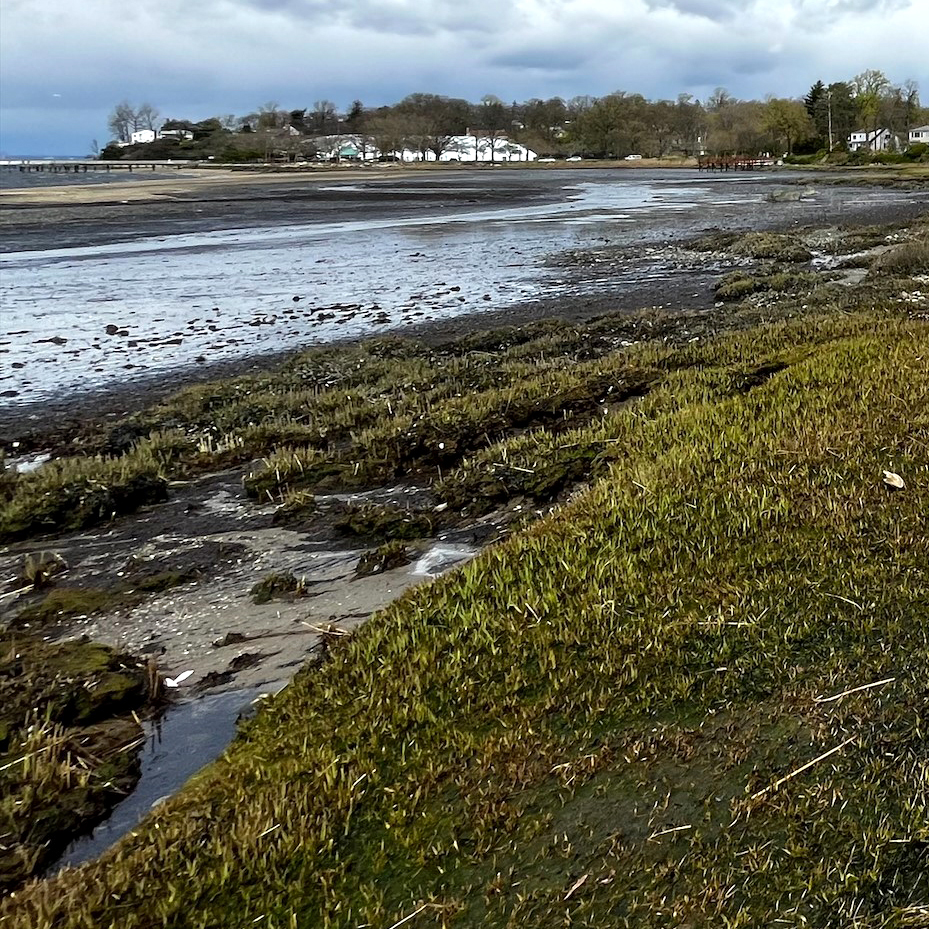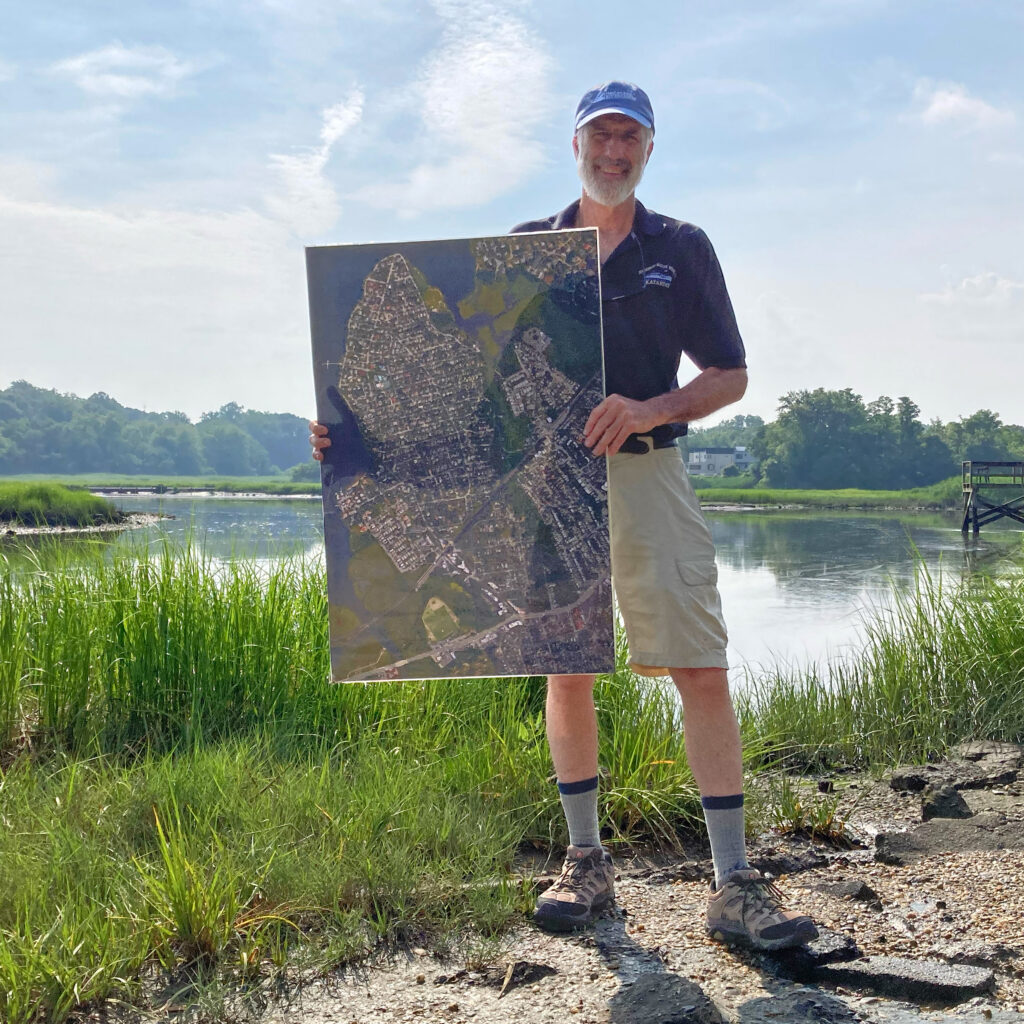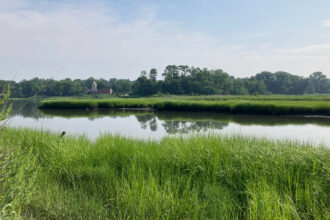New York City’s Marshes, Resplendent and Threatened
NEW YORK—Walter Mugdan looks out at the marshes that make up part of Udall’s Cove Park and Preserve in Little Neck, Queens. He points out the ospreys that inhabit one of the nesting platforms in the area, hoping to catch one of them diving down into the marsh for food.
Mugdan, 72, has lived alongside the marshes his entire life. A former deputy regional administrator for the Environmental Protection Agency, he now heads the Udalls Cove Preservation Committee, which is responsible for stewardship of the park.
“When I was a child, these areas that are now part of the park, we just called them ‘the swamps,’ and they were just a wonderful place to play—it was like being in a jungle,” said Mugdan. “The official trails that my organization takes care of—they were just originally invented by kids.”


The boundary between Queens and Long Island transects the park, as well as roadways and a railroad. Though the park is fragmented, these are some of the healthiest marshes in New York City, according to Mugdan. Today, the land is permanently protected and preserved—it would take as much as an act by the state legislature to attempt any kind of development in the area, said Mugdan.
Despite this, like many others across the city, these marshes are experiencing erosion due to sea level rise and storm surge amplified by climate change. The continued erosion of New York’s marshes could constitute an important threat to the water quality in the city’s waterways.
The city sits on land that was once defined by tidal wetlands and marshes. Across the five boroughs, over 80 percent of them have been filled in to make space for residential and industrial developments.
Read More

New York’s Marshes Plagued by Sewage Runoff and Lack of Sediment
By Lauren Dalban
Those that remain suffer the consequences of the changes to the city’s coast and the outlying areas. Humans have forever changed the flow of sediment to these remaining wetlands, and continue to do so through new developments and climate-induced sea level rise.
The lack of sediment flowing through New York waterways due to upstream dams, shipping channel dredging and coastal development limits the marshes’ elevation and weakens their structure, according to Dr. Dorothy Peteet, a senior research scientist with the NASA Goddard Institute for Space Studies who has studied the marshes for over 30 years.
She hopes new restoration initiatives, like placing a thin layer of sediment on top of the marshes to limit erosion, gather steam in the coming years.
“Unless we put sediment on top so [the marshes] can keep up, they’ll just be drowned,” said Dr. Peteet. “They’ll be underwater, and they’ll fall apart, which is really happening.”
Rich Habitats
The city’s marshes serve as habitats to a wide variety of wading birds and shorebirds, as well as horseshoe crabs and other fauna. As estuaries, these marshes are a part of one of the most productive ecosystems in the world due to their ability to provide habitat to so many species, particularly during early stages of life. Their indispensability as flood protection has also been widely documented, particularly since Hurricane Sandy.
The largest threats to the marshes depend on their location.
A 2017 strategy report published by the New York City Parks Department and the Natural Area Conservancy identified excessive inundation as the biggest threat to Queens marches because they tend to have the lowest elevation. This is particularly true of Jamaica Bay, where there are not only coastal salt marshes, but also newly reconstructed marsh islands.
Explore the latest news about what’s at stake for the climate during this election season.
By contrast, the marshes on the Long Island Sound, like Udall’s Cove, are more at risk for shoreline erosion due to structural weakness. Staten Island marshes are threatened by development pressure.
Alexandra Kanonik, the Jamaica Bay program director for the American Littoral Society, oversaw the monitoring and replanting of two marsh islands in the bay, which took place over the course of the last decade. They had been artificially elevated by the Army Corps of Engineers to increase flood protection in the area after Hurricane Sandy.
Today, Kanonik still sees constant marsh erosion in the bay.
“In a lot of the islands, the sand moves away and that creates instability for the whole island. Then, once you hit a certain threshold, chunks of marsh wash away—completely wash away—and end up somewhere else,” said Kanonik. “Sometimes it’s so bad that they could be mattress-sized washing up on the beach.”
Sea level rise accelerates the erosion of these marshes. After a winter cold spell earlier this year, Mugdan went out to monitor the Udall’s Cove marshes and found a deeply damaged shoreline. According to him, the area around the marsh freezes over when it gets very cold. When it suddenly got warmer and a storm came through the area, it pushed ice onto the marsh.
“The ice is very strong, very sharp and heavy, and it did tremendous damage to the shoreline here,” explained Mugdan. “We probably lost two feet of shoreline this past winter.”
Small mudflats pepper the shoreline along the Long Island side; Mugdan swears they used to be connected before last winter’s storm.
“The water is like eight inches higher right now,” said Mugdan. “So that’s where sea level rise is really hurting us.”
Heavy Metals: a Ticking Time Bomb
On the west shore of Staten Island, a short walk from large Amazon warehouses and behind a school bus parking lot, great egrets forage for food in Saw Mill Creek Marsh. Every couple of minutes, large cylindrical trucks speed across a bridge, reminding passers-by of the area’s industrial past and present. A side street behind a construction site leads onto the marsh, where views of the lush landscape are obscured by a mound of rotting tires and discarded construction materials.
In 2019, the New York City Economic Development Committee, in partnership with the New York City Parks Department, completed a restoration of 54-acres of the marsh as part of a larger pilot project to encourage private funding for large ecological restoration projects.

Saw Mill Creek Marsh, like many across the city, has a long history of illegal dumping. Its position near the Arthur Kill channel, a very busy waterway often frequented by oil tankers on their way to New Jersey, means that the city’s industrial past is not just confined to the marsh’s surface, but also to the depths below.
A lesser known consequence of marsh erosion is the release of various heavy metals and oil spills into New York’s waterways, possibly poisoning them for the fauna that forage and reside in and around them.
Heavy metal pollutants, like those released into the air, soil and water during the industrial revolution, and still to this day, stick to organic materials, like plants, in the marsh. When the plants decompose and are buried underneath new sediment, the pollutants remain there too. For scientists who study marshes, this process offers a look back at the history of pollution in that area.
In a 2018 study, Peteet detected lead and zinc sequestered in two marshes in Jamaica Bay.
“We have this refrigerator store of heavy metals, but if [the marshes] erode with sea level rise, then they go in the water, and that’s terrible for fish and crabs and birds,” said Peteet. “I try to get that message out, because nobody realizes how much lead, copper and zinc are in all these marshes.”
According to Peteet, these findings are not uncommon. She has found heavy metal contaminants in marshes located in much less polluted areas. In a study of an inland bog in the Catskills, Peteet found a high lead peak, despite being nowhere near any factories or polluted waterways. She believes the marshes are capturing the contaminants in the air, not just the water.
According to her studies, heavy metal pollutants are already slowly entering New York waterways due to erosion. Their current impact on wildlife is still largely unknown, though high levels of heavy metals are known to adversely impact the behavior of birds and their reproductive success. Scientists have long been asking whether contaminants in the waterways may partially account for bird population decline, like that of waterbirds and shorebirds.
In 2019, Christopher Vane, the head of organic geochemistry at the British Geological Survey, was conducting a study on rising sea levels in Saw Mill Creek Marsh in Staten Island when he unexpectedly found high levels of heavy metal pollutants, as well as the remnants of an oil spill within the marsh.
“I’ve sampled many oil spills, and this is the clearest cut oil spill—this is a textbook example,” said Vane. “More importantly, when you bring this [sediment] up, you can smell it. It smells very strongly of bitumen.”
Vane issued a warning that metals in the marsh, if released into the waterway, could constitute a “potent environmental threat” to the health of the harbor, according to established benchmarks for heavy metal contaminants.
“You’ve not only got multiple oil spill events, but you also have trace metals, which are a little harder to say exactly where they are coming from, some from aerial deposition, some from other sources,” said Vane. “But it’s definitely there.”
Limit Erosion, Hold in the Contaminants
Back in Queens, Mugdan walks through a short trail behind Memorial Field, a local park, and arrives at a small accessible expanse of shoreline looking out at the marsh. Holding a map, he points out the area where a community organization, the Douglas Manor Environmental Organization, in partnership with Save the Sound and numerous other groups, will soon start their marsh restoration project with funding from the Long Island Sound Futures Fund.
This will be a “living shoreline” project, which attempts to restore and strengthen a coastal marsh while also re-establishing it as a habitat for flora and fauna by planting native species and placing oyster castles along the shore for different marine species to use.
It will also protect a road that runs along the coast in this area from potential collapse. The marsh will protect the slope beneath it from further erosion, and stabilize the land so that it doesn’t wash out with storm surge or sea level rise
The city’s parks department also takes on marsh restoration initiatives, including digging to remove material that has been used to fill former marshes for coastal development.
“Sometimes, when you excavate down—it’s actually really cool—you’ll hit the historical peat,” said Rebecca Swadek, the director of wetland management at the parks department. “It’s, in some ways, actually a lot faster to be able to restore those functions if you have that as a base to start from.”
When the department excavates, they often test the soil for contaminants to ensure that the re-established marsh is as healthy as possible.
“Ultimately, I hate to say it, but we need another Hurricane Sandy to make people react again and say, ‘We need to do something now.’”
In recent years, the department has been experimenting with newer techniques for mitigating marsh erosion, like thin layer sediment placement. As Peteet described, they attempt to strengthen a marsh by pumping sediments onto it, replenishing its inorganic layers.
Before widespread coastal development, waterways would bring sediments to downstream marshes, which would help them increase their elevation and adapt to sea level rise. Thin layer sediment placement mimics that process, according to Swadek.
Though both Peteet and Swadek strongly believe in this technique’s efficacy, obtaining funding for it is much harder than for a tried-and-true approach like fill excavation, which has been used since the 1990s. Marsh restoration initiatives can be very costly, and many environmental organizations find themselves competing for limited resources.
“Ultimately, I hate to say it, but we need another Hurricane Sandy to make people react again and say, ‘We need to do something now,’” said Kanonik, who still works in Jamaica Bay. “Unfortunately, that’s how it works. You have to have a disaster for funding to come through.”
Despite limited investment in marsh restoration initiatives, stewards like Kanonik and Mugdan continue to watch over these indispensable ecosystems, hoping to keep them healthy, limit their loss to erosion and monitor the many species that forage, inhabit and grow on the marsh.
In 1997, Port Authority restored 13 acres of the marsh at Alley Pond Park in a mitigation effort connected to their extension of the LaGuardia runway. Mugdan took advantage of the temporary roadways they had installed to bolt an osprey nesting platform to a new telephone pole. Within a couple days, ospreys were nesting there.
“We now have seven or eight active osprey nests in this area; all are basically offspring of this original pair from when we built the platform. I feel very paternal towards these ospreys,” said Mugdan. “At high tide, I can kayak right through this little pathway here […] and I try to go and visit them.”
About This Story
Perhaps you noticed: This story, like all the news we publish, is free to read. That’s because Inside Climate News is a 501c3 nonprofit organization. We do not charge a subscription fee, lock our news behind a paywall, or clutter our website with ads. We make our news on climate and the environment freely available to you and anyone who wants it.
That’s not all. We also share our news for free with scores of other media organizations around the country. Many of them can’t afford to do environmental journalism of their own. We’ve built bureaus from coast to coast to report local stories, collaborate with local newsrooms and co-publish articles so that this vital work is shared as widely as possible.
Two of us launched ICN in 2007. Six years later we earned a Pulitzer Prize for National Reporting, and now we run the oldest and largest dedicated climate newsroom in the nation. We tell the story in all its complexity. We hold polluters accountable. We expose environmental injustice. We debunk misinformation. We scrutinize solutions and inspire action.
Donations from readers like you fund every aspect of what we do. If you don’t already, will you support our ongoing work, our reporting on the biggest crisis facing our planet, and help us reach even more readers in more places?
Please take a moment to make a tax-deductible donation. Every one of them makes a difference.
Thank you,
David Sassoon
Founder and Publisher
Vernon Loeb
Executive Editor
Share this article
Disclaimer: The copyright of this article belongs to the original author. Reposting this article is solely for the purpose of information dissemination and does not constitute any investment advice. If there is any infringement, please contact us immediately. We will make corrections or deletions as necessary. Thank you.
Title:New York City’s Marshes, Resplendent and Threatened
Url:https://www.investsfocus.com




